You have /5 articles left.
Sign up for a free account or log in.
Cries of financial distress from students unable to find private student loans have been relatively few and far between this fall, despite lots of newspaper headlines about a lack of availability of such loans. Interviews with many campus officials in recent weeks have indicated that while some campuses and students experienced delays in getting their money, and some borrowers were forced to pay more for their loans, few were deterred in any real way from pursuing their education.
A survey released Tuesday by the National Association of Independent Colleges and Universities, however, suggests that the student loan credit crunch has had an unexpectedly significant impact on the educational plans of students at private colleges. Because of how the survey is worded, gauging the exact scope of that impact, in terms of numbers of students, is difficult, and officials of the private college association said they could not ascertain that, either.
But the survey of about 500 colleges does suggest a meaningful impact. Fifty-seven percent of the colleges surveyed said that they had more than 10 students who had been unable to secure a private loan for the current academic year, and 49 colleges said they had at least 50 students who had been unable to secure loans -- most because they were unable to find someone to co-sign their loans.
When asked how the affected students were bridging the financial gap, survey respondents cited a range of responses, including participating in an institutional tuition repayment plan (52.6 percent of institutions), asking their parents to borrow federal PLUS loans for parents (48.8 percent), or paying with credit cards (34.3). But a staggering 45.8 percent of private colleges said that at least some of their students were "stopping out of school or switching to part-time status," a finding that conflicts with the widely held notion that students had not, by and large, been seriously deterred from pursuing their studies. (Another 38.3 percent said they were working more, which, depending on the situation, can obviously also have a deleterious effect on academic performance and college completion.)
In response to another question about the perceived impact of the credit crunch, 17.7 percent of independent colleges said they had enrolled fewer returning students than they had expected, and 19 percent had smaller incoming freshman classes than expected.
"We lost a large portion of our freshman class who were unable to secure a private loan and whose parents were either denied a PLUS loan or could not take one," said one unidentified respondent to the NAICU survey. Said another: "Most [students] who were unable to secure private loans were not able to attend."
Among other findings of the private college group's survey:
- Three quarters of colleges said student demand for financial aid had increased this year over last. To cover the increased demand, about 20 percent of all institutions that responded said they had turned to increased revenues (from raising tuition or fund raising), 17 percent said they had made cuts to other budget lines, and nearly 11 percent said they had dipped into their endowments.
- Eighty-five percent of respondents who participated in the federal guaranteed loan program said they had lost lenders because of the credit crunch, but just 10 percent said they had found the process of replacing them to be difficult. Nearly 90 percent of respondents said they had lost providers of private student loans, and more than a quarter said replacing them was difficult or extremely difficult.









